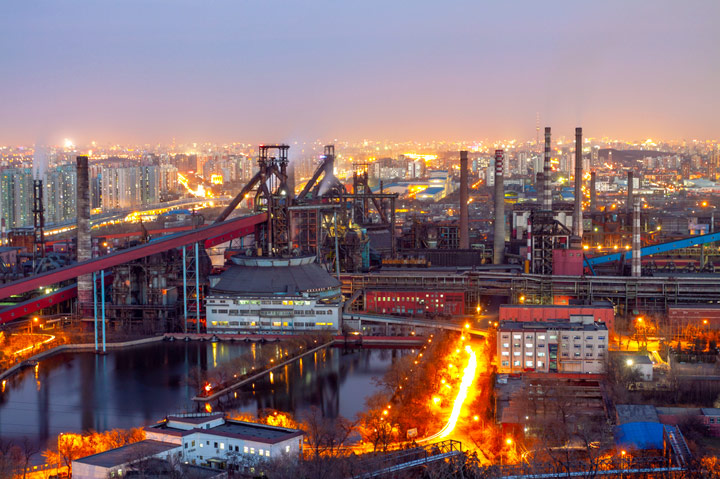News November 01, 2021
China’s Manufacturing Sector Limps Through October
Overall factory activity contracted and exports were down, an index showed. A separate index indicated tepid overall expansion, but a reduction in output.
Chinese manufacturing is in a mire.
For the second month in a row, China’s manufacturing sector contracted, according to the nation’s official purchasing managers’ index from the National Bureau of Statistics.

A view of the Beijing Shougang Industrial Zone.
The index posted a reading of 49.2 in October, down from 49.6 in September. October’s tally was the weakest showing since COVID-19 shutdowns crippled Chinese manufacturing in February 2020. Readings below 50 indicate contraction in the sector.
👀 China M'fg PMI vs US ISM M'fg PMI https://t.co/rpGkSamlM8 pic.twitter.com/tgihWEdVPC
— Michael Goodwell (@MichaelGoodwell) October 31, 2021
Meanwhile, a separate survey on Chinese manufacturing indicated the sector experienced a meager expansion. The Caixin China General Manufacturing Purchasing Managers’ Index posted a reading of 50.6 in October, up from 50 in September. Again, readings above 50 indicate expansion. Notably, however, the Caixin reading on manufacturing output in particular was in contraction territory – 48.8, down from 49 in September.
The overall September Caixin reading of 50 for manufacturing indicated neither expansion nor contraction, while that index told of retreat for the sector with a sub-50 reading in August.
“Shortages of raw materials and soaring commodity prices, combined with electricity supply problems, created strong constraints for manufacturers and disrupted supply chains,” Wang Zhe, a senior economist at Caixin Insight Group, said in a statement.
China's Caixin manufacturing PMI rose to 50.6 in Oct from 50.0 in Sept, an upside surprise.
— Jeffrey Kleintop (@JeffreyKleintop) November 1, 2021
Rising demand lifted new orders to 51.4 from 50.8, while output slipped to 48.8 from 49.0 on power rationing, supply shortages and rising costs.
PMI aligns with stabilizing profit growth. pic.twitter.com/7XW6mkZIFv
China’s manufacturing performance is relevant to the North American promotional products industry because the majority of products sold here are produced in Chinese factories and then imported. Slowdowns in productivity, for example, have the potential to affect promo products’ supply chains.
A subindex of the National Bureau of Statistics study showed that manufacturing exports didn’t fare well in China in October. The subindex’s reading of 46.6 on export orders was up a tick from September’s 46.2, but still indicated contraction.
A variety of factors are driving the slowdown in China’s manufacturing activity. One reason is that China’s factories have been contending with power rationing and blackouts. Some of that is a consequence of policies from Beijing that are intended to reduce carbon emissions and create a more energy-efficient economy.
The electricity pressures have potential to affect promo companies in the U.S. and Canada; if a factory from which a supplier sources, for example, doesn’t have power, it can’t produce goods for the North American branded merchandise market.
Governmental authorities in China have been taking steps to abate the power problems, but some analysts believe the power rationing and blackouts could drag on for months. That could further inhibit factory output and increase the cost of production/operations – inflation that could make its way down the supply chain to Western importers and, ultimately, consumers and B2B end-buyers.
